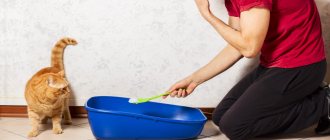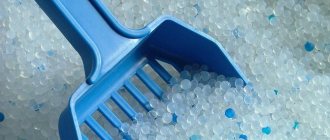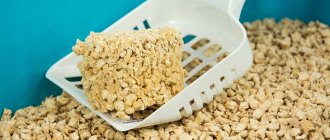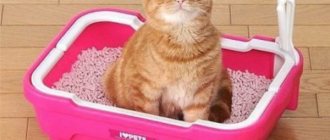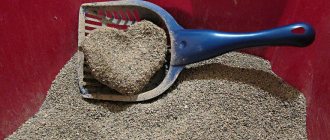Pets are our friends who cheer us up and help us relax after work. But caring for them can be difficult, especially in an apartment, when the animal does not go outside or prefers to do all its business in the house. Cat litter helps with hygiene issues, but the area may still smell unpleasant. And this is not what the owners of furry four-legged animals want to see. Therefore, today we will look at how to get rid of the smell of cat litter and keep your home clean if you have pets.
Clean the litter box often
Old feces and urine are not only unhygienic, but also emit a strong odor. What you can do is clean your kitty's litter box every day because the less often you clean the litter box, the more the smell will permeate your home. Research shows that at least 10% of cats stop using the litter box at some point, the most obvious reason being a dirty litter box in most cases. If you can't clean out their litter box every day, you may want to consider purchasing an automatic litter box.
© shutterstock
Clean your cat's litter box at least once a day, if not twice. Remove solid and liquid clumps if you are using clump litter. You can also use a hard metal spoon to remove urine-soaked areas each time you brush. Use a mild detergent to clean the litter box every week, depending on the type of litter box you may be using. Avoid using ammonia-based cleaners as they will only increase the odor.
Types of fillers
The result also depends on the choice of filler: some quickly become unusable and crumble, others maintain cleanliness for a long time. Which cat litter to choose?
clumping
This composition includes attapulgite, vermiculite and zeolite. The advantage is that after getting wet, the mass hardens - ready-made lumps are easy to remove with a scoop. Available in both versions: with and without flavoring.
Silica gel
These granules are your best friends when cleaning your cat's litter box. The components absorb liquid, but remain dry and prevent the spread of unpleasant odors. The disadvantages are the higher price and the reluctance of some cats to go to the toilet with such filler.
Woody
The filler is the cheapest. Available with aromatic additives or in natural form. The disadvantages are that when wet, the granules crumble, and during cleaning, pet owners are faced with an unpleasant odor.
Use deodorant
You can use baking soda as a deodorizer for your cat's litter box. There are also various perfumes or additives available in the market that can help keep the litter box odorless.
However, your kitten may not like the smell and may refuse to use the litter box as a result. You should try and experiment using these additives one at a time to find a deodorant that your cat likes. There are also unscented deodorants available that you can spray a little deodorant into each time you clean your kitty's litter box. However, veterinarians do not recommend using deodorant.
Woman wearing a gray spaghetti strap cleaning the blue little box or cat toilet, feeling stinky
Traditional methods for removing cat urine odor
remove the smell of cat urine using chlorine-containing products: Belizna, Sanita, and Domestos will help fight off the “aroma.” Soak a sponge in the solution and wipe the smelly area. True, such aggressive agents can ruin the fabric or carpet.
Popular advice includes in the list of effective substances hydrogen peroxide 3%, acids (malic, citric, acetic), potassium permanganate, iodine, soda, vodka, laundry soap, tea leaves and even tooth elixir.
The juice from one lemon is diluted in a glass of water. Vinegar is not used in its pure form: the proportions of vinegar and water are 1:3. Iodine is also used diluted - 20 drops are dissolved in 1 liter of water.
A good composition to fight off the stinking odor: 5 ml cap of dishwashing detergent and 100 ml of hydrogen peroxide. First, blot the stain with a rag, treat it with table vinegar and sprinkle with soda.
Apply lemon juice to the stain, cover it with baking soda, and after 5 minutes remove the foaming mixture. Afterwards, laundry soap and hydrogen peroxide will help. The remaining funds are removed with vodka.
The use of a washing vacuum cleaner will be logical only at the very last stage of cleaning: if the scene of the cat’s “crime” is not completely cleaned, and urine crystals remain, then you should not even think about getting rid of the remaining soda with a vacuum cleaner.
Get rid of cat urine smell from shoes
global $ads_google;
//data-ad-slot=”2475549904″ $ads_google = empty($ads_google) ? false : true; ?> if ($ads_google == false) {?> $ads_google = true; ?> } ?> If a fresh “surprise” is found in the shoes, then the liquid should be quickly blotted dry with a napkin. Damaged shoes are washed with water and laundry soap. Dish detergent will also work. The substance urochrome is treated with a solution of one part vinegar and 4 parts water. The mixture is applied to the stain.
If the shoes are leather, use lemon juice instead of vinegar to rub the area where the feces got in.
The hardest part is removing the uric acid crystals. Shoes are sprinkled with soda, and after a few minutes they are washed off. Instead of soda, you can take glycerin. Then the substance is removed with a napkin.
After washing the stain for the last time with laundry soap, the shoes are wiped and dried, pushing newspapers inside.
Eliminate odor from carpet
To get rid of cat urine smell from carpet, prepare baking soda, vinegar, hydrogen peroxide, water and dish detergent.
Blot the wet stain with dry wipes or rags. If you wet the area, the stain will dangerously spread, ruining an even larger area. Mix one part vinegar with three parts water, and after thoroughly blotting, moisten the stain with the solution. Further actions begin after the vinegar has completely dried.
The cat's crime scene is sprinkled with baking soda. After a few minutes, 100 ml of water, 100 ml of peroxide and 0.5 tsp are poured into the spray bottle. dishwashing detergents. After shaking the mixture, spray it onto the stain until foam forms. After 2 hours, everything is cleaned with a washing vacuum cleaner or a rag.
Remove odor from furniture
The smell of cat urine is removed from the sofa using potassium permanganate (potassium permanganate), iodine and water, citric acid solution, hydrogen peroxide, vodka, soda, glycerin or laundry soap.
Fresh stains after the cat urinates are removed using soap, vodka and a soda solution. If the sofa is light in color, then do not use potassium permanganate, while iodine will evaporate if you heat the stained surface with a hairdryer.
Stains after bowel movements are wiped with a vinegar solution and wait until dry. Then pour soda onto the damaged area or use a soda solution. If the urine is deep, then the solution is injected inside with a syringe, this will help get rid of the problem.
Remove odor from the floor
The smell of cat urine will linger in the apartment for a long time if it is not removed. There is a method that works effectively: prepare a solution of vinegar and water in a ratio of 1:3 and wash the floor three times. To avoid inhaling vinegar fumes, open windows while working.
You can remove the smell by thickly lathering the area with laundry soap. The soap dries out and is removed with water.
Another well-proven method for parquet: pour a tablespoon of vinegar into one and a half liters of mineral water. The product is sprayed from a spray bottle and after a while the floor area is wiped first with a damp and then with a dry cloth.
Effective recipes include a mixture of Bos washing powder and water and vodka. The floors are washed 2-3 times.
Privacy Policy
Introduction
We are committed to respecting the personal information of visitors to our site. This Privacy Policy explains some of the measures we take to protect your privacy.
Confidentiality of personal information
“Personally identifiable information” means any information that can be used to identify an individual, such as name or email address. Use of private information. Personally identifiable information collected through our site is used by us, among other things, for the purposes of registering users, maintaining and improving our site, tracking policies and site usage statistics, and for purposes authorized by you.
Disclosure of private information...
We employ other companies or are affiliated with companies that provide services on our behalf, such as processing and delivering information, posting information on this site, delivering content and services provided by this site, and performing statistical analysis. To enable these companies to provide these services, we may share personal information with them, but they will only be permitted to receive the personal information they need to provide the services. They are required to keep this information confidential and are prohibited from using it for other purposes. We may use or disclose your personal information for other reasons, including if we believe it is necessary to comply with the law or court orders, to protect our rights or property, or to protect the personal safety of users of our site or members of the general public. , to investigate or take action regarding illegal or suspected illegal activity, in connection with a corporate transaction such as a divestiture, merger, consolidation, sale of assets or in the unlikely event of bankruptcy, or for other purposes consistent with your consent. We will not sell, rent or lease our user lists with email addresses to third parties.
Access to personal information.
If, after providing information to this site, you decide that you do not want your personal information to be used for any purpose, please contact us at the following address: [email protected]
Our Practices Regarding Non-Personal Information.
We may collect non-personal information about your visit to the site, including the pages you view, the links you click, and other activities in connection with your use of our site. In addition, we may collect certain standard information that your browser sends to any website you visit, such as your IP address, browser type and language, time spent on the site, and the address of the website in question.
Using bookmarks (cookies).
Aggregated information.
We may combine in a non-identifiable format the personal information you provide and the personal information provided by other users, thereby creating aggregate data. We plan to analyze aggregated data primarily for the purpose of tracking group trends. We do not link aggregated user data to personally identifiable information, so aggregated data cannot be used to contact or identify you. Instead of using actual names, we will use usernames during aggregate data creation and analysis. For statistical purposes and to track group trends, anonymous, aggregated data may be provided to other companies with whom we interact.
Features and Recommendations
Removing this unpleasant and very pungent aroma is not easy, but it is possible. But if the problem repeats over and over again, you need to find out its causes and try to eliminate it. Yes, the cat marks the territory; this is a natural feature of individuals who want to meet their other half. The castration procedure will help resolve the issue.
But there are often situations when an animal that is not on a spree simply makes puddles, as they say, past the tray.
There may be several reasons for this:
- Uncleaned tray.
- Poor nutrition.
- Lack of water in the diet.
- The absence of owners for a long time, which deprives the pet of the attention it needs.
- Deviations in health: kidney function, other pathologies of the urinary system.
Contacting a veterinarian will help solve these problems. Only he will discover the true cause of unjustified puddles on the rug, sofa or under the door.
